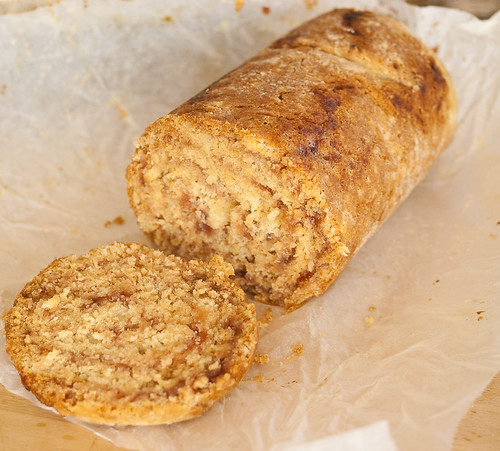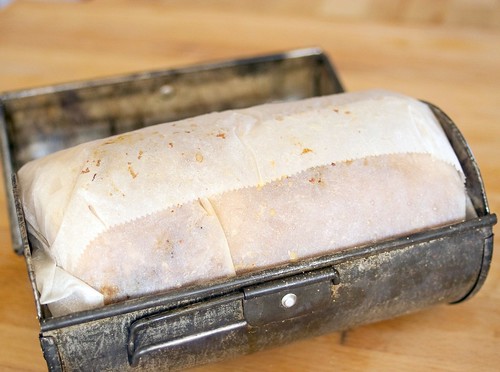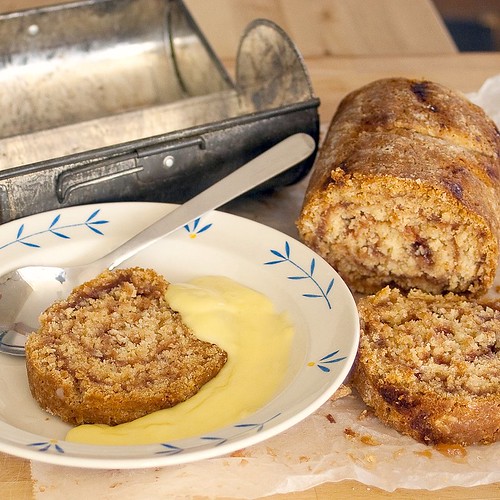It is unseasonably warm and blue outside so making such a traditional winter pudding seems a little anachronistic as I watch my courgette seedlings stretch up towards the sunlight, growing at least a centimetre a day. The Daring Baker challenge for this month was to make a pudding of suet pastry, suet was the only required ingredient, so this could have been anything from steamed treacle pudding to a wintery steak and kidney savoury pudding. I was at a loss for an idea of what to make until I found this, in a local junk/kitchenalia shop and when I found the original instructions inside, then my mind was made up - a jam roly poly in its' own proper tin.
Jam roly-poly is the epitome of proper English puddings, a suet pastry roll filled with sweet jam and cooked by a combination of steaming and baking, this pudding would be a familiar item to any school pupil educated in both state and private schools in the UK last century (and yes, of course that includes me!).
I compared the recipe supplied with the tin to the version that appears in the 1923 copy of Mrs Beeton's Cookery that was given to my Grandmother in that year and they were almost identical, Mrs B suggested less baking powder and more salt so I tweaked the recipe a little to find some middle ground.
A quick glance at more modern recipes revealed that very little else had changed, so I was ready to roll! Apparently jam roly-poly is also known as Dead Man's Leg, which is slightly less appetising I think. From that nick-name, the pudding then became known as Dead Man's Arm as house-wive's used the sleeves of their husband's old shirts to contain the pudding for baking, personally I think I will stick with roly-poly!
Creating a gluten free version took a little thought. I think that if I was really keen on this type of pudding, I would spend a little more time developing the pastry recipe. In an ideal world, the pastry would be more flakey and layered than my version, which is slightly softer in crumb than I would aspire to. The pastry for the pudding is not sweet, there is a touch of sugar to hint at the direction of the filling but the sweetness is supplied by the jam filling.
I used, quite literally, the first jar of jam I could find in my store cupboard. Now I have to own up that I have 3 batches of jam made last year, all of which were stashed in a cupboard quickly and label-less. I know, big sin! So when I grabbed the first jar, I was hoping for a thick strawberry jam with lots of fruit (and possibly a tad to much pectin) which would have remained in a thick layer between the rolls of the pudding. Unfortunately I grasped a jar of quince jelly, sweet yet gently acidic but soft rather than sticky in texture. The jam, as you can see in the picture, has soaked into the pastry a little, so the roll effect of the pastry is slightly less defined than I would like. This doesn't detract from the taste at all, and with a slick of home made custard, this makes a delicious and filling winter pudding. The pudding only takes about 15 minutes to put together, and an hour or so to cook, so it is not a difficult recipe to try (once the weather is cooler!).
Jam Roly-Poly
Ingredients
- 95g rice flour
- 50g corn flour
- 50g tapioca starch
- 1dsp arrowroot flour
- 1dsp psyllium husks
- 2 tsp baking powder
- 1/2 tsp salt
- 40g castor sugar
- 100g gluten free (or butcher's) suet
- 120ml milk
- 150g jam

- Mixing bowl
- baking paper
- foil,
- baking or roasting rack that fits inside a roasting tray
- Cut and grease a piece of baking paper approx 30cm square.
- Cut a piece of foil of a similar size (not needed if you have a roly poly tin).
- Preheat the oven to 200°C.
- Mix together all the ingredients except the jam to create a firm pastry.
- Tip the pastry out onto a floured surface and roll out to create a rectangle of pastry approx 15cm x 30cm (with the short side nearest you).
- Spread the surface of the pastry with all the jam.
- Roll up the pastry from the short end facing you, to create a roll 15cm by about 8cm deep.
- Using a couple of spatulas, lift the roll onto the greased baking paper and roll the baking paper loosely around the pudding (the pudding needs room to expand as it cooks).
- Fold the ends to create a tight seal, if you have a proper tin then pop the wrapped pudding into the tin and close. If not then wrap the pudding loosely in a piece of foil, again sealing the ends tightly but leaving room for the pudding to expand.
- Place the wrapped pudding on a roasting rack in a roasting pan filled with water to a level just below the roasting rack, loosely cover the pan with foil and place in the pre-heated oven for 1 hour.
- When the pudding is cooked remove the pan from the oven, and unwrap the pudding carefully, beware of any build up of steam.
- Cut the pudding into slices about 2cm wide and serve each slice with custard, cream or ice cream.














